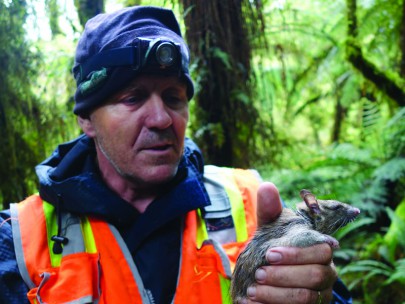Editorial: Research towards achieving a predator-free New Zealand

Grant Morriss and a sedated ship rat with radio collar attached, Lake Alabaster, Fiordland.
This is one of the most exciting times in New Zealand’s history to be either managing or studying predators. The challenge is huge, and the opportunities tremendous, but we won’t get there unless we address a number of important knowledge gaps. Manaaki Whenua is one of many New Zealand research providers helping to fill these gaps. Starting eight years ago with the landscape-scale predator control project at Poutiri Ao ō Tāne in Hawke’s Bay, and more recently at Cape-to-City, Manaaki Whenua scientists are now also helping Predator Free Taranaki, Predator Free Wellington, and Predator Free Dunedin with their research needs.
Achieving eradication of predators at a national scale requires quantum leaps in pest management. There are four key areas that need attention: (1) new tools and strategies for removing predators and defending against reinvasion; (2) more accurate methods of detecting predators at very low abundance; (3) statistical methods for declaring probability of success; and (4) public co-operation and involvement in the programme. This edition of Kararehe Kino addresses the technical aspects of predator eradication (1-3). Our social research on understanding and facilitating (4) will be featured in a future edition.
Dan Tompkins from Predator Free 2050 Ltd begins by setting the science scene and outlining the national research strategy that underpins the big research questions. An eradication strategy using dual 1080 bait switching is explained by Graham Nugent and Bruce Warburton. They found that two applications of 1080 bait in quick succession using different bait types has the potential to eliminate possums. The ability to defend eradicated areas by identifying reinvasion routes is addressed by Audrey Lustig and Simon Howard by modelling possum reinvasion between eradication zones on the Māhia Peninsula in Hawke’s Bay.
Andrew Veale’s article considers how to detect stoats at very low abundance using motion-triggered cameras. Provided adequate numbers of cameras are used and set correctly, cameras are a viable method for detecting residual stoats. Cameras have the advantage of not requiring predators to interact with them, so they have greater detection probability than many other devices. However, their disadvantage is the time they require to process thousands of images.
Fortunately, artificial intelligence is coming to the rescue. Al Glen discusses new software that automatically culls out images with no animals, and learns to identify species when they are present. This will be a huge cost saver.
Managers aim to ultimately detect no predators so that they can declare eradication. But zero detections do not necessarily mean zero predators if the array of detection devices and checking frequencies are insufficient to detect a predator that is present. Andrew Gormley and colleagues explain the statistical framework and software that allows managers to design robust detection networks, and to declare success with a given level of probability. A potential problem with applying this and other pest management software is that the essential animal behaviour parameters, such as interaction rates with devices, are not well quantified. Giorgia Vattiato and Rachelle Binny have reviewed what we already know about these parameters and, importantly, where the knowledge gaps lie. Much research is required in this area to constantly improve the models’ accuracy.
Finally, the lessons we can learn from fenced and unfenced ecosanctuaries, where predators have already been eradicated or suppressed over large scales, are discussed by John Innes and colleagues. They list seven key lessons relevant to achieving the PF2050 vision, one being that different native species are vulnerable to different mammals, and when one mammal (such as possums) is controlled, there is often an increase in another (such as ship rat). These two factors suggest that there will be more benefit for broad biodiversity recovery if multiple, rather than single, mammal pests are controlled at a site.
Finally, I’d like to thank our collaborating partners: Predator Free Hawke’s Bay, Hawke’s Bay Regional Council, Maungaharuru Tangitū, Whakatipu Māhia, Department of Conservation, Taranaki Regional Council, Taranaki Mounga Project, Predator Free Wellington, Greater Wellington Regional Council, Predator Free Dunedin, and Dunedin City Council for engaging with us in these fascinating areas of research. We are all on an exciting learning journey.

